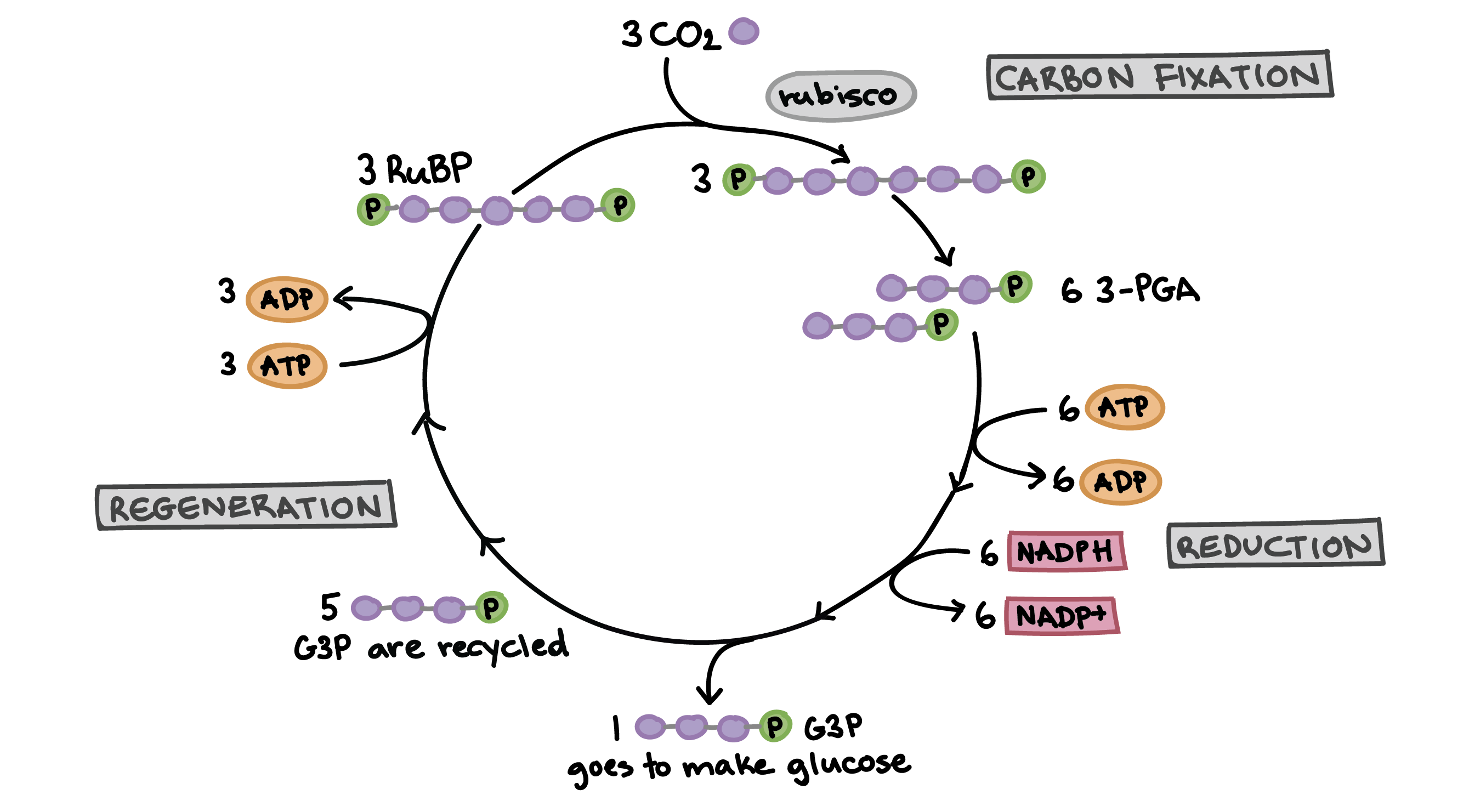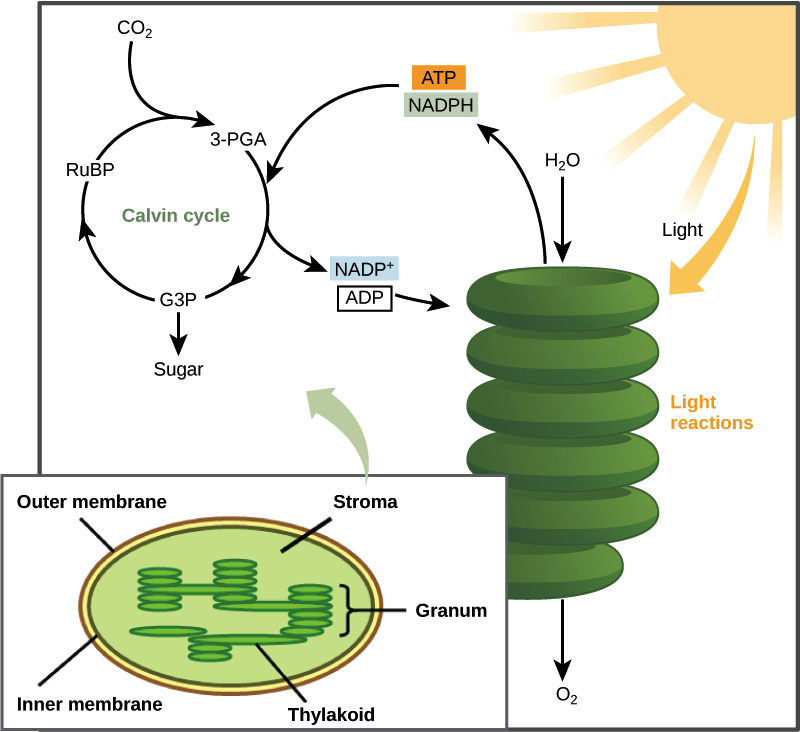The Calvin Cycle Oxidizes the Light-reactions Product
The NADPH and ATP produced are subsequently used to power the sugar-producing Calvin cycle. Does Calvin Cycle Produce Oxygen Or Light Reactions.

The Calvin Cycle Article Photosynthesis Khan Academy
Glucose ATP and O2 What are the three products of the light dependent reactions.
. The electrons derived from this oxidation reaction in the light reactions are used to reduce NADP to NADPH. The calvin cycle oxidizes the light reactions product _____ to ____ NADPH to NADP. The electrons derived from this oxidation reaction in the light reactions are used to reduce NADP to NADPH.
The Calvin cycle oxidizes the light-reactions product NADPH to NADP. In the light reactions light energy is used to oxidize H2O to O2. The Calvin cycle occurs at any time of the day while the light dependent reactions require light.
As part of the Calvin cycle where the chemical energy is derived from the light-independent reactions carbon dioxide molecule capture leads to sugar molecule assembly within the stroma. The electrons derived from this oxidation reaction in the Calvin cycle are used to reduce CO2 to G3P. The products of the light dependent reactions are used in the light independent reactions is ATP and NADPH.
The final product of the Calvin cycle is glucose. The calvin cycle produces glucose while the light dependent reactions produce oxygen ATP and. In the light reactions light energy is used to remove electrons from oxidize water producing O2 gas.
The Calvin cycle is part of photosynthesis which occurs in two stages. The ultimate goal of the light-independent reactions or Calvin cycle is to assemble a molecule of glucose. These reactions use chemical energy from NADPH and ATP that were produced in the light reactions.
The light independent reaction is the Calvin cycle. The electrons derived from this oxidation reaction in the Calvin cycle are used to reduce CO2 to G3P. The electrons derived from this oxidation reaction in the Calvin cycle are used to reduce CO2 to G3P.
Is oxygen a fuel. The reactions of the Calvin cycle add carbon from carbon dioxide in the atmosphere to a simple five-carbon molecule called RuBP. Correct In the light reactions light energy is used to remove electrons from oxidize water producing O 2 gas.
A light-dependent reaction releases oxygen as a byproduct when water is broken apart. As part of the Calvin cycle the citric acid is fermented thus causing sugar production through light reactions and NADPH. In the light reactions light energy is used to oxidize H2O to O2.
In the light reactions light energy is used to remove electrons from oxidize water producing O2 gas. These electrons are ultimately used to reduce NADP to NADPH. The electrons derived from this oxidation reaction in the Calvin cycle are used to reduce to G3P Part D Chloroplast structure and function In eukaryotes all the reactions of photosynthesis occur in various membranes and compartments of the chloroplast.
CO2 H2 O and NADPH. Some light energy is used to convert ADP to ATP. What is the main product of the Calvin cycle quizlet.
The Calvin cycle oxidizes the light-reactions product NADPH to NADP. What are the 3 products of light dependent reactions. These electrons are ultimately used to reduce NADP to NADPH.
This cycle releases ATP and NAPH. The Calvin cycle CalvinBensonBassham CBB cycle reductive pentose phosphate cycle RPP cycle or C3 cycle is a series of biochemical redox reactions that take place in the stroma of chloroplast in photosynthetic organismsThe cycle was discovered in 1950 by Melvin Calvin James Bassham and Andrew Benson at the University of California Berkeley by using the. In the second stage Calvin cycle or dark reactions carbon dioxide and water are converted into organic molecules such as glucose.
What molecule is released when water is split in the light reactions of photosynthesis. The light-independent reactions Calvin cycle use stored chemical energy from the light-dependent reactions to fix CO 2 and create a product that can be converted into glucose. Although the Calvin cycle may be called the dark reactions these reactions.
11292016 Photosynthesis I 612 ANSWER. Citric acid cycle products-3 NADH-1 FADH2 1 GTP or ATP. The Calvin cycle oxidizes the light reactions product.
In the light reactions the energy of sunlight is used to oxidize water the electron donor to O2 and pass these electrons to NADP producing NADPH. In the first stage chemical reactions use energy from light to produce ATP and NADPH. The electrons derived from this oxidation reaction in the Calvin cycle are used to reduce CO2 to G3P.
The Calvin cycle oxidizes the light-reactions product NADPH to NADP. The product of the Calvin cycle is a triose-phosphate sugar that is either exported from the chloroplast or used to regenerate RUBP. These electrons are ultimately used to reduce NADP to NADPH.
The Calvin cycle oxidizes the light-reactions product NADPH to NADP. Photophosphorylation which follows a different circular path involves electrons that are produced exclusively with a positively charged energy called adenosine A molecular weight no NADPH. The Calvin cycle oxidizes the light-reactions product to co 02 4.
Citric acid Krebs cycle. In the Calvin cycle NADPH is oxidized back to NADP which returns to the light reactions. NADPH to NADP The electrons derived from this oxidation reaction in the Calvin cycle are used to reduce.

The Calvin Cycle Article Photosynthesis Khan Academy
What Happens During The Calvin Cycle In Photosynthesis Quora

No comments for "The Calvin Cycle Oxidizes the Light-reactions Product"
Post a Comment